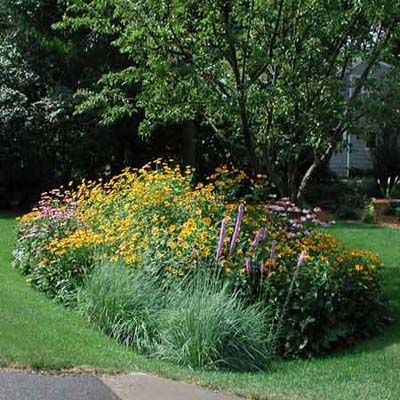Rain gardens are great way to manage stormwater runoff. These shallow, plant-filled depressions help filter water and prevent pollutants from entering local waterways, all while beautifying your yard.
In the Ask This Old House segment above, environmental scientist Peter Phippen helps landscape contractor Jenn Nawada and a homeowner create a rain garden that filters contaminants and benefits local ecosystems. Learn more in our guide below.
Rain Garden Basics

Rain gardens serve as natural water filtration systems. They capture and slowly absorb runoff from roofs, driveways, and other impervious surfaces. This process helps prevent pollutants from entering nearby water bodies and replenishes groundwater supplies.
Purpose and Benefits
Rain gardens offer numerous advantages for both homeowners and the environment:
- Beautifies your yard: Native plants create a vibrant landscape.
- Requires little maintenance: Once established, rain gardens need minimal care.
- Prevents flooding and erosion: Helps control surface water and stop soil erosion.
- Supports local wildlife: Attracts birds, butterflies, and beneficial insects.
- Reduces water pollution: Filters out contaminants before they reach local water systems.
Ideal Locations
To make the most of your rain garden, it’s important to choose the right spot. Here are some factors to keep in mind:
- Distance from your home: Pick a location at least 10 feet away from your house to avoid water damage.
- Runoff collection: Place the garden where it can collect runoff from downspouts, driveways, or other paved areas.
- Avoid septic systems and steep slopes: Stay at least 40 feet away from septic systems and avoid areas with sharp slopes.
- Check drainage: Make sure the area isn’t constantly soggy and allows for proper water drainage.
Designing Your Rain Garden

A well-designed rain garden should be both functional and visually appealing. Think about the following elements when planning your garden.
Size and Shape
The size of your rain garden depends on the amount of runoff it needs to handle. While precise calculations can be helpful, you can also start small and expand as needed. A typical residential rain garden ranges between 100 and 300 square feet.
Soil Composition
The soil in your rain garden should promote quick drainage while supporting plant growth. A recommended mixture is:
- 1/3 coarse sand
- 1/3 compost
- 1/3 bark mulch
This combination provides proper filtration and provides nutrients for your plants.
Plant Selection
Choose native plants that can tolerate both wet and dry conditions. Arrange them in three zones based on their water needs:
- Center: Plants that thrive in wet soil, like native sedges and lady ferns.
- Middle: Species that can handle occasional standing water, such as red twig dogwood.
- Outer edges: Plants that prefer drier soil, such as native evergreen or deciduous shrubs.
Steps To Create a Rain Garden
Follow these steps to build your own rain garden:
- Check for underground utilities: Contact your utility companies to mark any underground pipes or wires before digging.
- Outline garden borders: Use marking paint to define the area.
- Remove grass and roots: Clear the area of existing vegetation using a shovel.
- Dig the basin: Excavate to a depth of 18 inches, removing the soil.
- Add coarse sand: Spread 1–2 inches of sand at the bottom for drainage.
- Place your plants: Arrange plants while they’re still in their pots to plan the layout.
- Prepare plant roots: Remove the plants from their pots and gently loosen their roots.
- Backfill with soil mixture: Use your prepared mixture to fill around the plants.
- Water thoroughly: Saturate the soil to help settle it, then apply a layer of bark mulch.
- Establish the plants: Water regularly for the first month to help the plants take root.
Maintaining Your Rain Garden
Once your rain garden is established, it will need minimal maintenance, but here are some simple tasks to keep it in top shape:
- Cleaning: Remove any debris or sediment annually.
- Mulching: Replace mulch annually to maintain a 2-inch layer.
- Pruning and dividing: Trim and divide plants as they grow.
- Watering: Water during dry spells for the first growing season.
- Weeding: Keep weeds at bay to maintain plant health and appearance.
Common Rain Garden Plants
Selecting the right plants is foundational for a successful rain garden. Here are some popular native plant options:
- Black-eyed Susan: Bright yellow flowers that grow in a variety of conditions
- Summersweet (Clethra alnifolia): Fragrant blooms that attract pollinators
- Joe Pye weed: Adds height and attracts butterflies
- Native blueberries: Provide food for birds and add seasonal interest
- Switchgrass: Adds structure and sways gracefully in the wind
These plants are well-suited to the mix of wet and dry conditions found in rain gardens.
Addressing Potential Challenges
While rain gardens are generally low-maintenance, you may encounter some issues:
- Salt tolerance: In coastal areas or where road salt is used, choose salt-tolerant plants like beach plum, little bluestem, or switchgrass.
- Soil composition: If your soil is heavy with clay or too sandy, you may need to amend it with more compost or sand for proper drainage.
- Wildlife damage: While attracting wildlife is a benefit, you may need to protect certain plants from being damaged by animals.
Site-Specific Challenges
Each site is unique, and certain challenges may arise during the planning and installation of your rain garden. Be aware of these site-specific challenges:
- Heavy rainfall regions: In areas with heavy rainfall, make sure the rain garden has adequate overflow paths to prevent flooding and manage excess water.
- Sloped areas: For properties with significant slopes, terracing the rain garden or using retaining walls can help manage water flow and prevent erosion.
- Urban environments: In urban areas with limited space, smaller rain gardens can still be effective. Utilize compact designs and select plants that thrive in confined spaces.